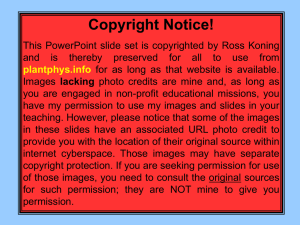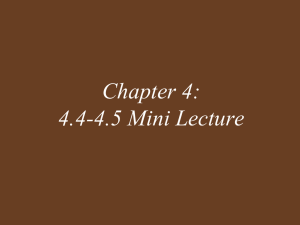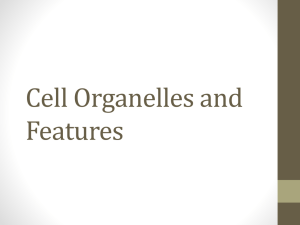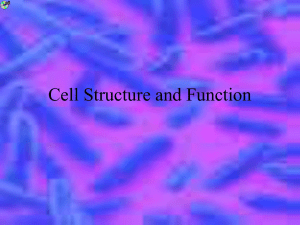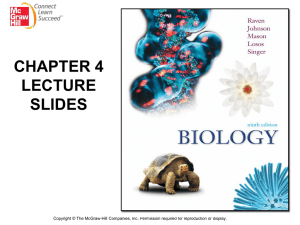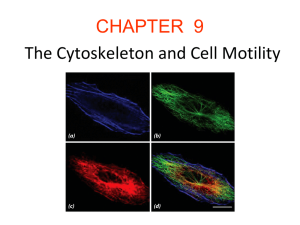chapter4_part2
advertisement
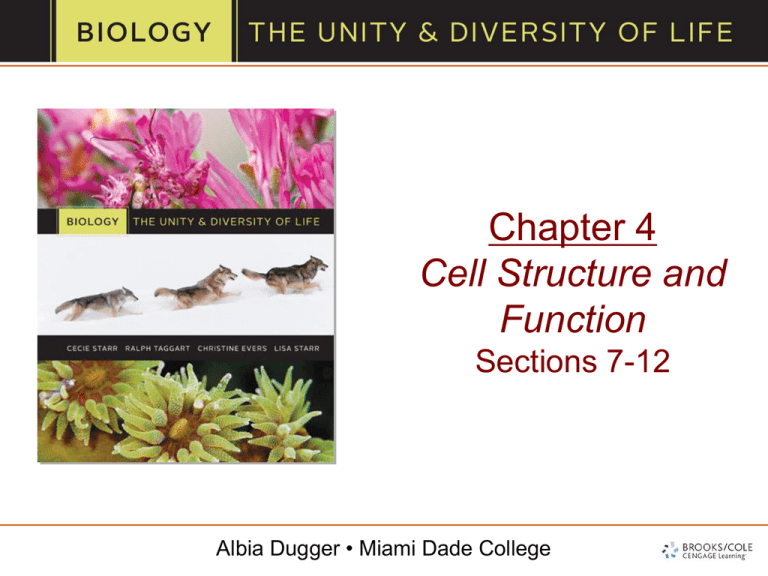
Chapter 4 Cell Structure and Function Sections 7-12 Albia Dugger • Miami Dade College 4.7 The Endomembrane System • Endomembrane system • A series of interacting organelles between the nucleus and the plasma membrane • Makes, modifies, and transports proteins and lipids for secretion or insertion into cell membranes • It also destroys toxins, recycles wastes, and has other specialized functions Rough ER Modifies proteins made by ribosomes attached to it Smooth ER Makes lipids, breaks down carbohydrates and fats, inactivates toxins Golgi Body Finishes, sorts, ships lipids, enzymes, and proteins Lysosome Digests, recycles materials p64 The Endoplasmic Reticulum • Endoplasmic reticulum (ER) • An extension of the nuclear envelope that forms a continuous, folded compartment • Two kinds of endoplasmic reticulum • Rough ER (with ribosomes) folds polypeptides into their tertiary form • Smooth ER (no ribosomes) makes lipids, breaks down carbohydrates and lipids, detoxifies poisons Vesicles • Vesicles • Small, membrane-enclosed saclike organelles that store or transport substances • Peroxisomes • Vesicles containing enzymes that break down hydrogen peroxide, alcohol, and other toxins • Lysosomes • Vesicles containing enzymes that fuse with vacuoles and digest waste materials Vacuoles • Vacuoles • Vesicles with various functions depending on cell type • Many isolate or dispose of waste, debris, and toxins • Central vacuole • Occupies 50 to 90 percent of a cell’s interior • Stores amino acids, sugars, ions, wastes, toxins • Fluid pressure keeps plant cells firm Golgi Bodies • Golgi body • A folded membrane containing enzymes that finish polypeptides and lipids delivered by the ER • Packages finished products in vesicles that carry them to the plasma membrane or to lysosomes The Endomembrane System polypeptide RNA 1 nucleus Rough ER 3 ribosome attached to ER Vesicles vesicle budding from ER Figure 4-15 p64 2 Smooth ER 4 Golgi body 5 Plasma membrane protein in smooth ER Figure 4-15 p65 ANIMATED FIGURE: The endomembrane system To play movie you must be in Slide Show Mode PC Users: Please wait for content to load, then click to play Mac Users: CLICK HERE Take-Home Message: What is the endomembrane system? • The endomembrane system includes rough and smooth endoplasmic reticulum, vesicles, and Golgi bodies • This series of organelles works together mainly to synthesize and modify cell membrane proteins and lipids 4.10 Lysosome Malfunction • When lysosomes do not work properly, some cellular materials are not properly recycled, which can have devastating results • Different kinds of molecules are broken down by different lysosomal enzymes • One lysosomal enzyme breaks down gangliosides, a kind of lipid Tay Sachs Disease • A genetic mutation alters the lysosomal enzyme that breaks down gangliosides, which accumulate in nerve cells – affected children usually die by age five Take-Home Message: Are all organelle types necessary for life? • Defects in the function of an organelle can have devastating consequences to health 4.11 Other Organelles • Eukaryotic cells make most of their ATP in mitochondria • Plastids function in storage and photosynthesis in plants and some types of algae Mitochondria • Mitochondrion • Eukaryotic organelle that makes the energy molecule ATP through aerobic respiration • Contains two membranes, forming inner and outer compartments; buildup of hydrogen ions in the outer compartment drives ATP synthesis • Has its own DNA and ribosomes • Resembles bacteria; may have evolved through endosymbiosis outer membrane outer compartment inner compartment inner membrane Figure 4-17 p67 ANIMATED FIGURE: Structure of a mitochondrion To play movie you must be in Slide Show Mode PC Users: Please wait for content to load, then click to play Mac Users: CLICK HERE Plastids • Plastids • Organelles that function in photosynthesis or storage in plants and algae; includes chromoplasts, amyloplasts, and chloroplasts • Chloroplasts • Plastids specialized for photosynthesis • Resemble photosynthetic bacteria; may have evolved by endosymbiosis A Photosynthetic cells in a leaf of Plagiomnium ellipticum, a moss. Figure 4-18a p67 two outer membranes stroma thylakoids (inner membrane system folded into flattened disks) Figure 4-18b p67 ANIMATED FIGURE: Sites of photosynthesis To play movie you must be in Slide Show Mode PC Users: Please wait for content to load, then click to play Mac Users: CLICK HERE Take-Home Message: What organelles produce ATP? • Mitochondria are eukaryotic organelles that produce ATP from organic compounds in reactions that require oxygen • Chloroplasts are plastids that carry out photosynthesis in cells of plants and many protists 4.10 The Dynamic Cytoskeleton • Eukaryotic cells have an extensive and dynamic internal framework called a cytoskeleton • Cytoskeleton • An interconnected system of many protein filaments – some permanent, some temporary • Parts of the cytoskeleton reinforce, organize, and move cell structures, or even a whole cell Components of the Cytoskeleton • Microtubules • Long, hollow cylinders made of tubulin • Form dynamic scaffolding for cell processes • Microfilaments • Consist mainly of the globular protein actin • Make up the cell cortex • Intermediate filaments • Maintain cell and tissue structures tubulin subunit A Microtubule Figure 4-19a p68 actin subunit B Microfilament Figure 4-19b p68 dimer tetramer sheet of tetramers coiled sheet forms a ropelike bundle 8–12 nm C Intermediate filament Figure 4-19c p68 ANIMATED FIGURE: Cytoskeletal components To play movie you must be in Slide Show Mode PC Users: Please wait for content to load, then click to play Mac Users: CLICK HERE Microtubules and Microfilaments in a Nerve Cell Motor Proteins • Motor proteins • Accessory proteins that move molecules through cells on tracks of microtubules and microfilaments • Energized by ATP • Example: kinesins Motor Protein: Kinesin ANIMATED FIGURE: Motor proteins To play movie you must be in Slide Show Mode PC Users: Please wait for content to load, then click to play Mac Users: CLICK HERE Cilia and Flagella • Eukaryotic flagella and cilia • Whiplike structures formed from microtubules organized into 9 + 2 arrays • Microtubules grow from a barrel-shaped centriole, which remains in the cytoplasm below as a basal body pair of microtubules dynein “arms” plasma membrane A Sketch and micrograph of a eukaryotic flagellum, cross-section. Like a cilium, it contains a 9 + 2 array: a ring of nine pairs of microtubules plus one pair at its core. Stabilizing spokes and linking elements that connect to the microtubules keep them aligned in a radial pattern. (Plasma membrane not visible in the micrograph.) Figure 4-21a1 p69 B Projecting from each pair of microtubules in the outer ring are “arms” of dynein, a motor protein. Phosphate-group transfers from ATP cause the dynein arms to repeatedly bind the adjacent pair of microtubules, bend, and then disengage. The dynein arms “walk” along the microtubules. Their motion causes adjacent microtubule pairs to slide past one another. basal body (microtubule organizing center that gives rise to the 9 + 2 array and then remains beneath it, inside cytoplasm) Figure 4-21b p69 C Short, sliding strokes occur in a coordinated sequence around the ring, down the length of each micro- tubule pair. The flagellum bends as the array inside bends. Figure 4-21c p69 ANIMATED FIGURE: Flagella structure To play movie you must be in Slide Show Mode PC Users: Please wait for content to load, then click to play Mac Users: CLICK HERE False Feet • Pseudopods or “false feet” • Temporary, irregular lobes formed by amoebas and some other eukaryotic cells • Bulge outward to move the cell or engulf prey • Elongating microfilaments force the lobe to advance in a steady direction • Motor proteins attached to microfilaments drag the plasma membrane along with them Take-Home Message: What is a cytoskeleton? • A cytoskeleton of protein filaments is the basis of eukaryotic cell shape, internal structure, and movement • Microtubules organize eukaryotic cells and help move their parts; networks of microfilaments reinforce their surfaces; intermediate filaments strengthen and maintain the shape of animal cells and tissues • When energized by ATP, motor proteins move along tracks of microtubules and microfilaments; as part of cilia, flagella, and pseudopods, they can move whole cells 4.11 Cell Surface Specializations • Many cells secrete materials that form a covering or matrix outside their plasma membrane • Extracellular matrix (ECM) • A nonliving, complex mixture of fibrous proteins and polysaccharides secreted by and surrounding cells • Structure and function varies with the type of tissue • Example: Bone is ECM composed mostly of the fibrous protein collagen, hardened by calcium and phosphorus Eukaryotic Cell Walls • Animal cells do not have walls, but plant cells and many protist and fungal cells do • Primary cell wall • A thin, pliable wall formed by secretion of cellulose into the coating around young plant cells • Secondary cell wall • A strong wall composed of lignin, formed in some plant stems and roots after maturity primary cell wall plasma membrane cytoplasm pipeline of abutting cell walls secondary cell wall (deposited in layers) middle lamella primary cell wall A Secretions of plant cells form the middle lamella, a layer that cements adjoining cells together. B In many plant tissues, cells also secrete materials that are deposited in layers on the inner surface of their primary wall. These layers strengthen the wall and maintain its shape. The walls remain after the cells die, and become part of the pipelines that carry water through the plant. Figure 4-22ab p70 ANIMATED FIGURE: Plant cell walls To play movie you must be in Slide Show Mode PC Users: Please wait for content to load, then click to play Mac Users: CLICK HERE Cuticle • Cuticle • A type of ECM secreted by cells at a body surface • Plant cuticles consist of waxes and proteins, and help plants retain water and fend off insects • Cuticles of crabs, spiders, and other arthropods is mainly chitin, a polysaccharide Plant Cuticle thick, waxy cuticle at leaf surface outer cell of leaf photosynthetic cell inside leaf Cell Junctions • Cell junctions allow cells to interact with each other and the environment • In plants, plasmodesmata extend through cell walls to connect the cytoplasm of two cells • Animals have three types of cell junctions: tight junctions, adhering junctions, gap junctions Cell Junctions in Animal Tissues tight junctions Cell Junctions in Animal Tissues free surface of epithelial tissue tight junctions adhering junction gap junction basement membrane ANIMATED FIGURE: Animal cell junctions To play movie you must be in Slide Show Mode PC Users: Please wait for content to load, then click to play Mac Users: CLICK HERE Take-Home Message: What structures form outside cells? • Cells of many protists, nearly all fungi, and all plants have a porous wall around the plasma membrane; animal cells do not have walls • Plant cell secretions form a waxy cuticle that helps protect the exposed surfaces of soft plant parts • Cell secretions form extracellular matrixes between cells in many tissues • Cells make structural and functional connections with one another and with extracellular matrix in tissues 4.12 The Nature of Life • We define life by describing the set of properties that is unique to living things • Life is a property that emerges from cellular components, but a collection of those components in the right amounts and proportions is not necessarily alive • Life continues only as long as a continuous flow of energy sustains its organization Properties of Living Things 1. They make and use the organic molecules of life 2. They consist of one or more cells 3. They engage in self-sustaining biological processes such as metabolism and homeostasis 4. They change over their lifetime, for example by growing, maturing, and aging 5. They use DNA as their hereditary material 6. They have the collective capacity to change over successive generations… by adapting to environmental pressures Life Take-Home Message: What is life? • We describe the characteristic of “life” in terms of a set of properties that are unique to living things • In living things, the molecules of life are organized as one or more cells that engage in self-sustaining processes • Organisms use DNA as their hereditary material • Living things change over lifetimes, and over generations Summary: Components of Prokaryotic and Eukaryotic Cells

